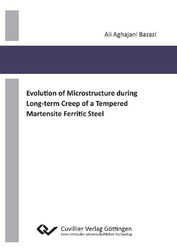| Fachbereiche | |
|---|---|
| Buchreihen (96) |
1378
|
| Nachhaltigkeit |
3
|
| Gesundheitswesen |
1
|
| Geisteswissenschaften |
2363
|
| Naturwissenschaften |
5406
|
| Ingenieurwissenschaften |
1791
|
| Allgemeine Ingenieurwissenschaften | 292 |
| Maschinenbau und Verfahrenstechnik | 861 |
| Elektrotechnik | 686 |
| Bergbau- und Hüttenwesen | 30 |
| Architektur und Bauwesen | 75 |
| Allgemein |
98
|
|
Leitlinien Unfallchirurgie
5. Auflage bestellen |
|
Erweiterte Suche
Evolution of Microstructure during Long‐term Creep of a Tempered Martensite Ferritic Steel
Ali Aghajani Bazazi (Autor)Vorschau
Inhaltsverzeichnis, Datei (49 KB)
Leseprobe, Datei (190 KB)
Tempered martensite ferritic steels are used for critical components in fossil fired power plants that operate in the creep range. The materials contain a high density of dislocations and precipitates form on all types of internal interfaces, the majority of which represent subgrain boundaries. Most previous studies suffer from either only relating to short term creep experiments or from being incomplete in not considering all relevant elements of the microstructure. No systematic effort was made to investigate the evolution of microstructures under conditions of long term creep. In the present study the evolution of the microstructure of a 12% Cr tempered martensite ferritic steel was investigated under conditions of long term aging and creep. Transmission electron microscopy (TEM) and electron back scattered diffraction (EBSD) techniques were used to characterize materials from interrupted creep tests (0.5%, 1%, 1.6% and rupture at 11.9%; creep conditions: 550°C, 120 MPa, rupture time: 139 971 h). It is shown that subgrains coarsen, that the close correlation between carbides and subgrain boundaries loosens during long term creep, and that the frequency of small angle boundaries increases. In addition, the evolution of dislocation densities during long term aging and creep was studied using high angle annular dark field (HAADF) scanning transmission electron microscopy (STEM). During aging the dislocation density remains constant, while during long term creep the dislocation density continuously decreases. All these elementary deformation processes have already been discussed in short term creep studies. The present study shows that they also govern long term creep, however, during long term creep, precipitation and coarsening reactions occur which are not observed during short term creep. Cr rich M23C6, VX carbides and Laves phase were identified as the major precipitates in the microstructure of the 12% Chromium tempered martensite ferritic steel. Their chemical compositions, sizes, volume fractions and number densities were evaluated in all interrupted specimens. M23C6 particles coarsen and establish their equilibrium concentration after 51072 hours. VX particles are stable. The Laves phase particles do not reach thermodynamic equilibrium as they form and grow during long term creep. This is due to Silicon which is found in the Laves phase particles and which diffuses slowly in the steel matrix.
| ISBN-13 (Printausgabe) | 3869551828 |
| ISBN-13 (Printausgabe) | 9783869551821 |
| ISBN-13 (E-Book) | 9783736931824 |
| Sprache | Englisch |
| Seitenanzahl | 118 |
| Auflage | 1 Aufl. |
| Band | 0 |
| Erscheinungsort | Göttingen |
| Promotionsort | Ruhr-Universität Bochum |
| Erscheinungsdatum | 08.12.2009 |
| Allgemeine Einordnung | Dissertation |
| Fachbereiche |
Maschinenbau und Verfahrenstechnik
|








